Christmas on the Home Front
by Bob Brooke
Celebrating Christmas
during World War II was a challenge for most people, except for perhaps
the very wealthy. Just about every family had at least one member in the
Armed Forces. The constant worries for those loved ones serving in the
armed forces, away from home at the time of year when many families
would gather together to celebrate, made it difficult for most.
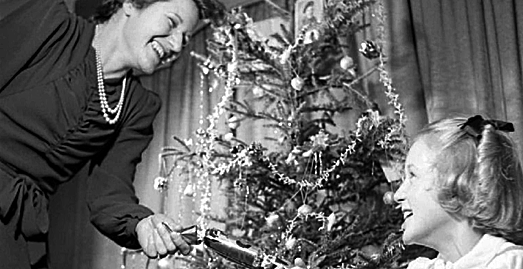
Today, it’s hard to imagine how families coped during World War Two.
However, despite all these challenges, many families managed to put
together a very successful festive celebration.
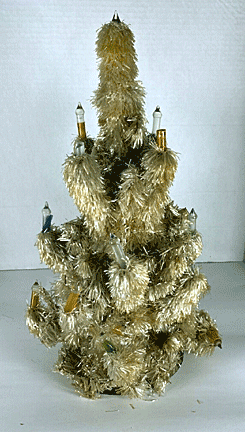 Although
the blackout meant there were no Christmas lights in the streets,
families still enthusiastically decorated their homes for the holiday
season. Cut-up strips of old newspaper made very effective paper chains,
holly and other garden greenery adored the pictures on the walls, and
pre-war decorations and glass baubles decorated make-do Christmas trees.
And people could find tips for making these simple decorations even more
festive. Although
the blackout meant there were no Christmas lights in the streets,
families still enthusiastically decorated their homes for the holiday
season. Cut-up strips of old newspaper made very effective paper chains,
holly and other garden greenery adored the pictures on the walls, and
pre-war decorations and glass baubles decorated make-do Christmas trees.
And people could find tips for making these simple decorations even more
festive.
During World War II Christmas trees were in short supply because of a
lack of manpower to cut the trees down and a shortage of railroad space
to ship the trees to market. Americans rushed to buy American-made Visca
artificial trees. In 1941, a five-foot Christmas tree could be purchased
for 75 cents.
Though artificial Christmas trees had been both imported to and
manufactured in the United States for decades at that point, this was
when the faux firs really gained traction. Prior to the war, artificial
Christmas trees made from goose feathers were the most popular variety.
But after the U.S. stopped importing goods from Germany—including the
feather trees—they were no longer available. Instead, people opted for
artificial Christmas trees made in America using visca, a type of
artificial straw, or those from the UK-based Addis Housewares Company,
which used their machinery for making toilet brushes to produce faux
trees with similarly stiff bristles.
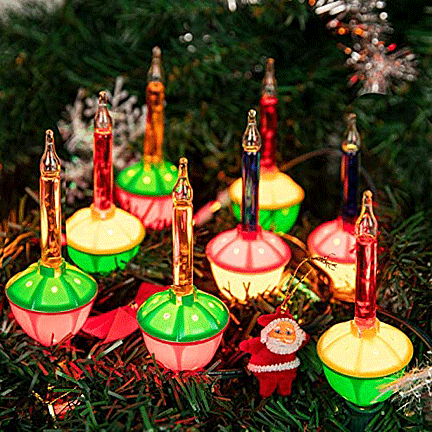 World
War II also brought about changes to how Christmas trees were decorated.
“The tradition of lighting a tree at this time of year has been around
for a very long time, But you couldn’t have done that in parts of the
United States during the war—especially on the coasts—because you had to
blackout your windows at certain times. World
War II also brought about changes to how Christmas trees were decorated.
“The tradition of lighting a tree at this time of year has been around
for a very long time, But you couldn’t have done that in parts of the
United States during the war—especially on the coasts—because you had to
blackout your windows at certain times.
Electric bubble lights
were created during the 1940s and remain popular even today. To give
their Christmas tree a snow-covered effect, people mixed a box of Lux
soap powder with two cups of water and brushed the concoction on the
branches of their tree.
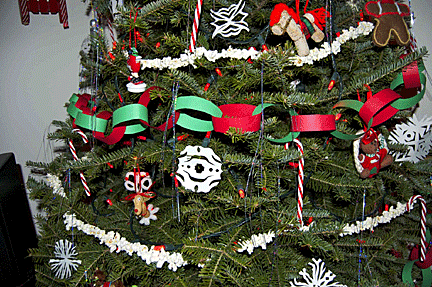 Many
Americans threw their German blown-glass ornaments and exotic Japanese
ornaments in the trash as soon as the war began. And the shortage of
aluminum and tin, used to produce ornaments, led many people to make
their own ornaments at home. Magazines contained patterns for ornaments
made out of non-priority war materials, like paper, string, and natural
objects, such as pine cones or nuts. Many
Americans threw their German blown-glass ornaments and exotic Japanese
ornaments in the trash as soon as the war began. And the shortage of
aluminum and tin, used to produce ornaments, led many people to make
their own ornaments at home. Magazines contained patterns for ornaments
made out of non-priority war materials, like paper, string, and natural
objects, such as pine cones or nuts.
 Since
wrapping paper was scarce, people wrapped homemade gifts in brown paper,
newspaper, or even small pieces of cloth. Scarves, hats and gloves might
be hand knitted using wool unraveled from old sweaters. People purchased
war bonds to give as gifts, thus helping the war effort. Homemade
jellies and jams made welcome presents. Practical gifts were also
popular, especially those associated with gardening, such as homemade
wooden garden trowels for planting. The most popular Christmas present
in 1940 was soap. Since
wrapping paper was scarce, people wrapped homemade gifts in brown paper,
newspaper, or even small pieces of cloth. Scarves, hats and gloves might
be hand knitted using wool unraveled from old sweaters. People purchased
war bonds to give as gifts, thus helping the war effort. Homemade
jellies and jams made welcome presents. Practical gifts were also
popular, especially those associated with gardening, such as homemade
wooden garden trowels for planting. The most popular Christmas present
in 1940 was soap.
For many people, sharing a special meal with family and friends is an
integral part of celebrating the holidays. So, when the U.S. government
began rationing various foods in 1942, households across the country had
to rethink what they would serve for the occasion.
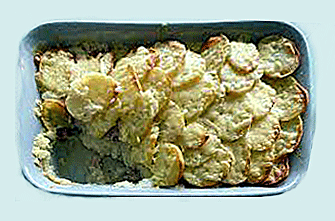 With
rationing, Christmas dinner became an ingenious affair. Cooks hoarded
ingredients for weeks and even months in advance. Americans saved up
their food ration stamps to provide extra food for a fine holiday meal.
The Federal Government increased ration amounts for coffee, tea, and
sugar rations at Christmas which helped cooks to create a festive meal.
Turkey wasn’t on the menu in the war years. Those lucky enough might
have goose, lamb or pork. A home-raised chicken was also a popular
alternative for the main meal, accompanied by plenty of homegrown
vegetables. As the war progressed, cooks substituted “mock” concoctions
to replace Christmas fare became “mock,” for example ‘mock’ goose ( a
form of potato casserole) and ‘mock’ cream. And lot of people gave up
turkey so that the Government could ship more turkeys to service people
overseas. With
rationing, Christmas dinner became an ingenious affair. Cooks hoarded
ingredients for weeks and even months in advance. Americans saved up
their food ration stamps to provide extra food for a fine holiday meal.
The Federal Government increased ration amounts for coffee, tea, and
sugar rations at Christmas which helped cooks to create a festive meal.
Turkey wasn’t on the menu in the war years. Those lucky enough might
have goose, lamb or pork. A home-raised chicken was also a popular
alternative for the main meal, accompanied by plenty of homegrown
vegetables. As the war progressed, cooks substituted “mock” concoctions
to replace Christmas fare became “mock,” for example ‘mock’ goose ( a
form of potato casserole) and ‘mock’ cream. And lot of people gave up
turkey so that the Government could ship more turkeys to service people
overseas.
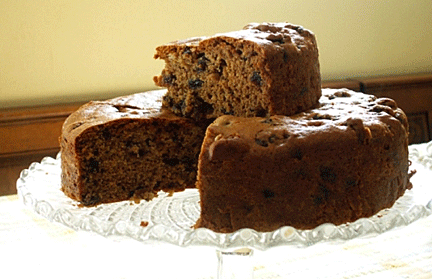
Sugar was the first food
to be rationed during World War II, with butter added to the list the
following year. Victory cakes, which used very little sugar (if any)
were a popular option, as were gelatin-based desserts.
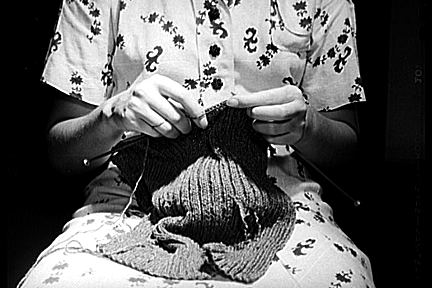 The
war also impacted the types of presents placed under the tree. “Families
often exchanged fewer gifts among the adults to make sure the kids got
their toys and other fun things,” says Green. But thanks to wartime
rationing of commodities like metal, rubber, and rayon, many
manufactured children’s toys and gifts were made of wood or paper. The
war also impacted the types of presents placed under the tree. “Families
often exchanged fewer gifts among the adults to make sure the kids got
their toys and other fun things,” says Green. But thanks to wartime
rationing of commodities like metal, rubber, and rayon, many
manufactured children’s toys and gifts were made of wood or paper.
it was common to both give and receive handmade presents during World
War II. “Knitting and crocheting really took off, and so did painting
and all kinds of crafts. They were often created using repurposed
materials and supplies. The U.S. government encouraged Americans to make
a patriotic sacrifice for the common good, and purchase war bonds for
loved ones in lieu of traditional presents.
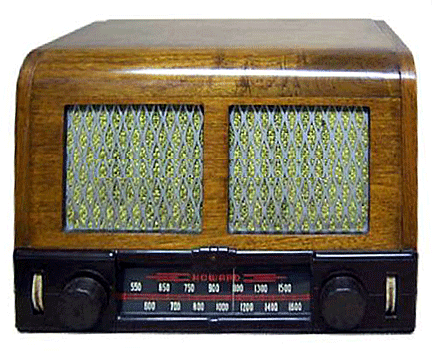 Radios
provided entertainment. Sing-a-longs and party pieces, card games and
board games were very popular when friends and family got together over
the Christmas holidays. Some of the most popular Christmas songs, such
as “White Christmas” and “I’ll be Home for Christmas,” date from the
early 1940s. Radios
provided entertainment. Sing-a-longs and party pieces, card games and
board games were very popular when friends and family got together over
the Christmas holidays. Some of the most popular Christmas songs, such
as “White Christmas” and “I’ll be Home for Christmas,” date from the
early 1940s.
Christmases during World War II had an underlying feeling of melancholy
for both the Americans serving overseas, as well as those on the home
front with empty places at the dinner table. Some of the most somber
holiday standards were released during this period: “White Christmas”
(1941), “I’ll Be Home for Christmas” (1943), and “Have Yourself a Merry
Little Christmas” (1944).
This trio of now-classic songs resonated with soldiers longing for home,
and their loved ones who dreamt of Christmases like the ones they used
to know. As Green says, “Referring to [being home for Christmas] ‘if
only in my dreams’ captured a lot of what was happening."
Fewer men at home resulted in fewer men available to dress up and play
Santa Claus.
Women served as substitute Santas at Saks Fifth Avenue in New York City
and at other
department stores throughout the United States.
Most people stayed home
or visited neighbors within walking distance during the holidays.
Rationing of tires and gasoline limited holiday travel.
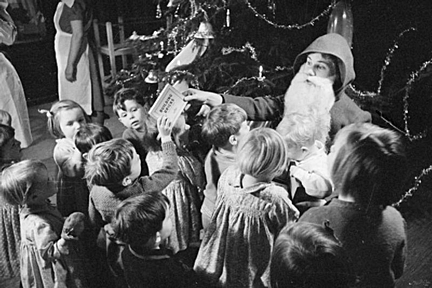
Looking back with modern eyes at these frugal, make-do-and-mend war
years, it’s easy for people today to feel sorry for those spending
Christmas back then. However if you ask those who lived through the war,
many will say that they look back fondly on their childhood Christmases.
The simpler wartime Christmas was for many, a return to simple joys; the
company of family and friends, and the giving and receiving of gifts
made with care by loved ones.
<
Back
to More Back in Time
Next Article > |
